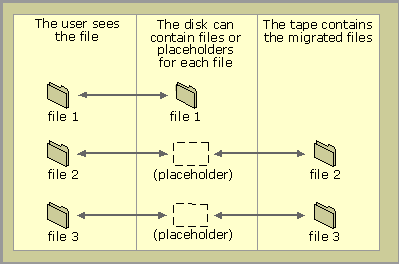Basic Concepts
Remote Storage manages data in local storage, moving less-used data to remote storage, making local storage available for new data. Remote Storage automatically manages the movement of data between local storage and remote storage according to administrator-defined guidelines set for each local storage volume. The administrator-defined guidelines consist of:
- Desired Free Space. The amount of free space specified to be kept on the managed volume.
- File Selection Criteria. Criteria that determine which data is eligible for movement to remote storage.
To prepare for the need to free space on local storage, Remote Storage regularly premigrates (copies) the unnamed data attribute of all eligible NTFS files on local storage to remote storage making these files premigrated files. The last access time of the file does not change when a file is premigrated. When free space on local storage is less than the Desired Free Space, premigrated files are automatically and immediately converted to placeholders until the desired amount of free space is available. A placeholder is an NTFS file which points to the copy of its unnamed data attribute in remote storage and has its unnamed data attribute truncated (removed) from local storage. The placeholder is marked with FILE_ATTRIBUTE_OFFLINE. Even though Remote Storage has changed the physical size of the file on local storage, the logical size and the date/time (create, last modified, last accessed) of the file remains unchanged. Users or applications (for example, disk quotas) that utilize file size are not affected by Remote Storage data migration. Users see all files regardless of storage location, as shown in Figure 2.5.

Enlarge figure
Figure 2.5 File Migration Representation
If a user or application reads, writes, or memory maps a placeholder that was opened using the normal NTFS open request (with no special flags), the unnamed data attribute of the file is automatically recalled from remote storage to local storage, returning this file to the premigrated file status, and the request completes. The latency of the first read, write, or memory map depends on the following criteria:
- The type of remote storage (random access or serial access).
- If remote storage is removable media, whether or not the media is mounted.
- The speed of the device accessing the data (drives or head speed).
- The availability of the devices in remote storage.
- Whether or not there is space to recall the file on local storage.
Notification can be issued to the user when the recall takes a while to complete. If remote storage is inaccessible, the open request fails.

Note
FILE_FLAG_OPEN_NO_RECALL is a new flag supported for Windows 2000. If the open request is issued with the new FILE_FLAG_OPEN_NO_RECALL flag, the requested amount of data is read and cached internally and returned to the caller. However, the file remains truncated. The file is read-only, and the data is placed directly into the read buffer, bypassing local storage. The file remains truncated.
If the open request is issued with the FILE_FLAG_BACKUP_SEMANTICS flag, the unnamed data attribute of the file is not recalled. This allows backup programs prior to Windows 2000 to interact with Remote Storage. FILE_FLAG_OPEN_
NO_RECALL is added for the legacy backup programs so that the file can be backed up without being recalled.
If you do not want legacy backup applications to back up Remote Storage files, you can set the registry value HKEY_LOCAL_MACHINE\SYSTEM
\CurrentControlSet\Services\RSFilter\Parameters\SkipFilesForLegacyBackup to 1. Restarting or stopping and starting Remote Storage is required for this change to take effect.
Placeholders and premigrated files can be renamed without affecting the management of the data. When placeholders or premigrated files are copied, the file is recalled and the entire file contents are copied to the new file. The original file remains a premigrated file, while the new file is neither a placeholder nor a premigrated file.
Remote Storage provides disaster prevention and recovery features, including:
- The ability to generate multiple media copies of removable media.
- The ability to replace damaged removable media while Remote Storage is running.
- The ability to recover from loss of Remote Storage metadata.
Remote Storage interfaces are integrated with Windows 2000 Explorer and the Disk Management snap-in. The Remote Storage snap-in allows an administrator to:
- Allocate and configure Remote Storage remote storage devices and media.
- Set Remote Storage systemwide feature options.
- Configure Disk Management settings for Remote Storage–managed volumes.
- View information about Remote Storage activity.
- Recover from media disasters.
- Create and submit jobs.
Remote Storage restricts the number of data paths accessing remote storage. Objects are copied into remote storage using one data path while objects are recalled to local storage using the second data path. Data might be entering and leaving remote storage at the same time, but multiple data paths in the same direction are not allowed.

Note
The maximum size of data managed is equal to the amount of media within a storage pool.
The minimum size of managed data is the size which results in space being reclaimed in local storage. This is equal to the amount of space used in the master file table (MFT) record for the file to hold the placeholder data.
© 1985-2000 Microsoft Corporation. All rights reserved.
EAN: N/A
Pages: 404